It’s interesting how its nomenclature includes “shark,” but it is not from a shark family. It has got its name because it looks similar to sharks. If you can maintain their expense and care routine, iridescent sharks are very fun.
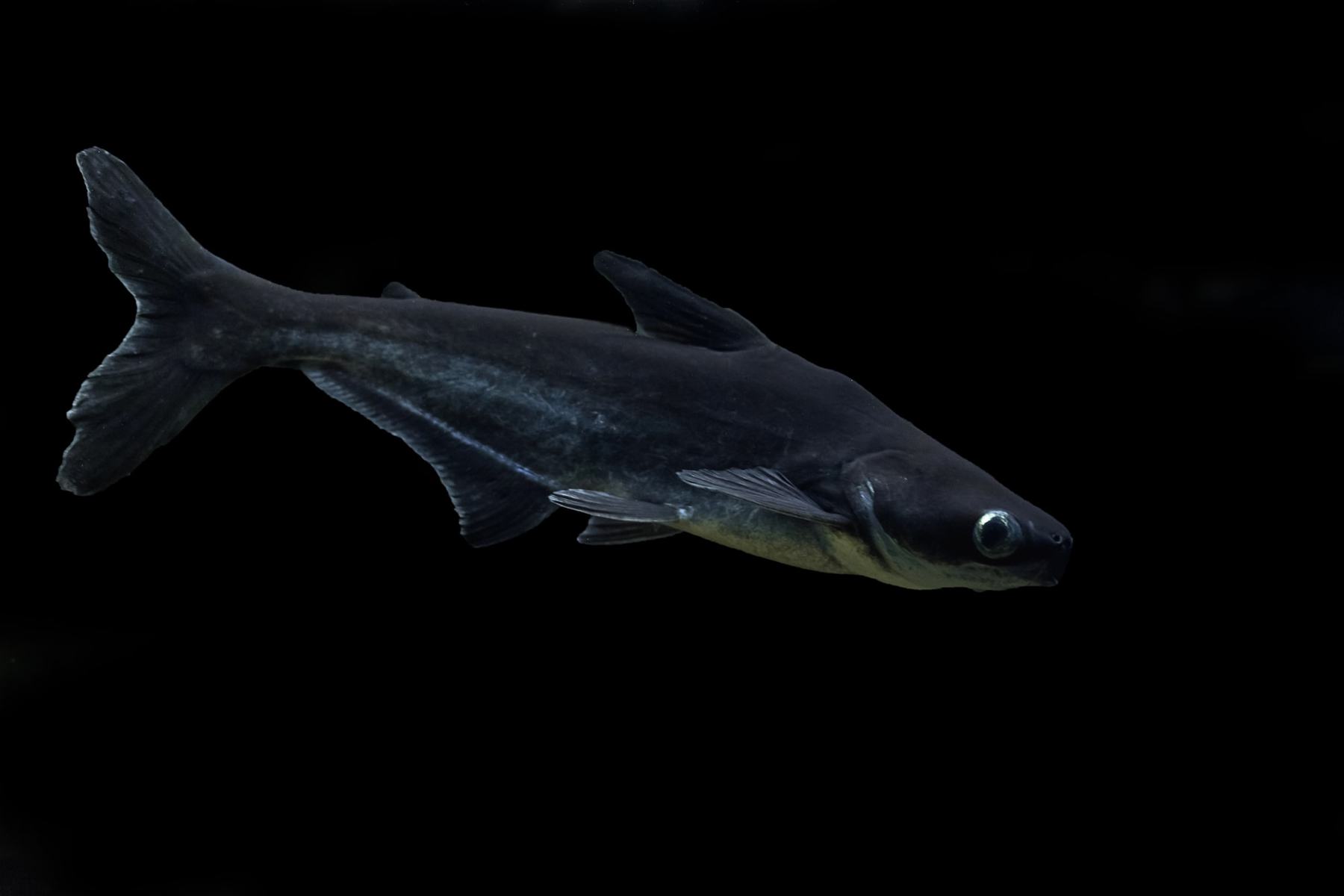
Table of Contents
Iridescent Shark: A Brief Introduction
The Iridescent Shark, also known as the Siamese Shark or the Sutchi Catfish, is a species of catfish native to the Mekong Basin in Southeast Asia. It is known for its distinctive iridescent coloration and long, slender body. It is a popular aquarium fish and is often sold as a food fish in its native range.
Iridescent Shark: Overview
When it comes to iridescent shark care, there are a few things you will want to take into consideration before getting one, and the best way to make an educated decision for your tank is to inform yourself ahead of time properly. You have to consider fish tank size and the temperament, personality, and behavior of the sutchi catfish to make sure you can provide it with everything it needs. It isn’t necessarily difficult to care for but does require additional consideration and beforehand knowledge.
Knowing what to expect is important before you bring any fish (and especially catfish) into a tank, and iridescent sharks need additional consideration. They can live for up to 20 years, which is a very long time for a fish, so make sure you will be able to provide it with adequate iridescent shark care for as long as it lives before you invest time, effort, and money in this peaceful fish. When these impressive animals are kept alone in a tank, they are not unusual to experience stress and anxiety.
A considerate aquarium owner should always keep more than one iridescent shark or provide appropriate tank mates.
| Information Chart | Iridescent Shark |
|---|---|
| Scientific Name: | Pangasianodon hypophthalmus |
| Family: | Pangasiidae |
| Care Level: | Intermediate |
| Temperament: | Peaceful |
| Color: | Grey, White |
| Lifespan: | More than 20years |
| Size: | 44kgs (Adult) |
| Minimum Tank Size: | 300 gallons |
| Temperature: | 72-79 degrees F |
| Water Conditions: | 2-20 dGH |
| Tank Mate Compatibility | Friendly |
Iridescent Shark Appearance
Catfish usually have their body covered in bony plates, but this siamese shark is different from other similar fish and is sometimes referred to as a naked catfish. They are eye-catching and iridescent – more so when they are juveniles, and below the lateral line, you will find two black stripes running parallel.
This is unique for the juveniles and a great way to determine a fish’s age, and they become increasingly grey as they grow older. The fins are black or dark grey. The lines on their bodies are more than just a nice visual detail, and they have nervous tissue that becomes beneficial for the siamese shark when wanting to detect water changes. The reason isn’t that they have poor eyesight, but instead that they often swim in murky waters.
The female Siamese shark is often slightly larger than the male, and the shape of their bodies tends to have more volume to it – making female fish easy to distinguish, which is especially great for when wanting to breed iridescent sharks. Iridescent sharks also have long barbels that resemble whiskers, which is more of a typical feature found in most fish of this type. Their barbels are characteristic and give them an interesting look, and it is hard to mistake this fish for any other species.
One interesting fact about iridescent sharks is that they are also called ‘naked fish’ because they lack bony plates over their body. They have thin skin and are generally found in the water column’s middle.
Types Of Iridescent Shark
Albino Iridescent Shark
Albino iridescent sharks are very similar to normal iridescent sharks except that they are white and shiny with red eyes.
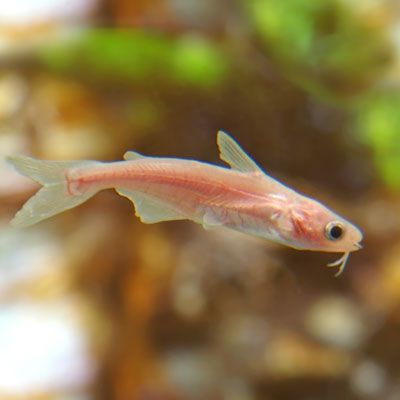
Lifespan Of Iridescent Shark
Iridescent Sharks live up to twenty years or more if you provide them with a happy and healthy environment to grow. Studying the lifespan of iridescent sharks is important to understand their growth rate and movement.

If proper space or care is not given to them, their lifespan can be unfairly shrunk depending on their living conditions. A decent amount of capital is also needed to maintain them since they live up to twenty years. That is why; you should only bring Iridescent sharks if you are an aquarist, have good knowledge of fish, and have enough money to maintain them for more than twenty years.
Iridescent Shark Size
Adults can grow up to 44kgs and 130cm in length, three to four feet! Initially, buyers see it small and buy it, but in later phases, they face problems maintaining them because of their size. In their juvenile phase, they can be as small as 20-25cms. So, you must be prepared with a larger aquarium if you are planning to grow an iridescent shark. However, their growth is relatively lesser in aquariums than it is in rivers. If not put under good condition, their health can deteriorate, eventually leading to a shorter lifespan.
Natural Habitat And Origin
The iridescent shark pangasianodon inhabits the Chao Phraya River and the Mekong basin. In these areas, this large fish is often used for its meat as food. The name “Swai” is what the meat of iridescent sharks tends to be sold as, and it is considered a delicacy in many areas. In recent years, the Pangasianodon hypophthalmus has grown in popularity as an aquarium fish, and it can now be found in aquariums all over the world.
The name can seem a little confusing because it is a catfish and not a shark, but there is a logical explanation. Despite being a fish, it physically resembles a shark, and the name is also inspired by the way juvenile sutchi catfish glow body. Measures are being taken to ensure that the iridescent shark thrives in the wild due to its unique breeding behaviors. Still, it has also become a popular aquarium species for those who have the space and the time to dedicate to caring for it.
Iridescent Shark Care & Tank Set-Up
Taking care of iridescent sharks can be fun if you do it the right way. You might think it is a complex process, but it initially looks complex. With time, you will enjoy the process.
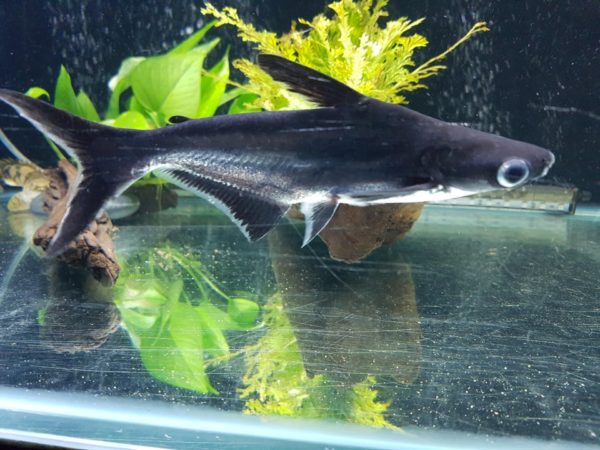
Moreover, there is nothing difficult except managing a big tank to accommodate the iridescent sharks.
Tank Size And Specifications
An iridescent shark needs a nice and large tank to swim around in, and you will want to give these fish a tank with at least 300 gallons. This should make it clear that the siamese shark is not made for regular small aquariums, so consider the size of the tank and whether you have space for one before you proceed.
Optimum Tank Size For Iridescent Shark
The recommended tank size for Iridescent Sharks is 300 gallons. This is only applicable for one iridescent shark. Of course, you will have to add more iridescent sharks to it. So, you will need to add 150 gallons for every additional iridescent shark. The fish is not comfortable living alone, so you at least need to keep five fish along with the Iridescent shark for its happy growth. Now imagine the tank size and decide wisely.
Do not get played by seeing the initial size of the fish. Buyers commonly put juvenile iridescent sharks to a 40 gallons tank, but later they find it hard to adjust.
Tank Shape For Iridescent Shark
It is best if you can buy an oblong-shaped tank. Since Iridescent Sharks are very playful, they need a lot of space to swim. Moreover, since these fish do not have any bone plates, an oblong shape will better avoid accidents.
Being as large as the iridescent sharks are, you might even want to consider keeping them in a pond instead of in an aquarium (however, this requires additional knowledge and precaution). Still, if you choose to keep them in a tank, it cannot be stretched enough how important it is to get one big enough to give them the freedom to swim around. As mentioned above, an iridescent shark does not like to be alone, and for every fish you add, you need more space and more water.
Filter Type
The iridescent shark can be quite the little mess-maker, and they tend to get their tank dirty fast.
For this reason, you need to make sure you have a strong filter and that you are also cleaning the water regularly, as these fish (despite being messy themselves) do not thrive in dirty water. Many experts recommend changing approximately 25% of the water in the tank every week, something that will inevitably be time-consuming considering the large tanks fish like these need. Knowing what you sign up for when getting iridescent sharks for fish tanks is crucial to succeeding, as you might end up keeping them for up to 20 years.
Be gentle and careful when changing the water and cleaning the tank, because as we have already talked about above – the iridescent shark scares easily, which could end up damaging your tank or even harming your fish. You should also keep the tank in a calm area of your home, if possible, with minimal disturbance. These are fish that look very large and impressive, but they can end up hurting themselves quite severely if spooked. If they were to jump out of the tank when you are not present, then your fish is likely to die, so make sure you provide a calm environment, especially when you are not around to supervise.
Substrate
Do it at the bottom if you want to add something to the tank. You can add pebbles or rocks and driftwood inside the tank. Since Iridescent lives in rivers, pebbles will give them a more natural environment to grow and play in. Just keep it in mind to give adequate space for the fish to move freely.
Since the skin of this fish species is very delicate, you need to be extra careful while selecting substrates. So, try to replicate the river conditions only and nothing more. They are comfortable swimming in river beds that only have soft mud, and thus, harsh additives in the tank can be harmful to them.
You should also keep in mind the iridescent size before adding substrates. If they get scared of something, they can bash into the equipment in the tank. So, if you put water heaters or any other substrate, try to hide them from the fish where they cannot be broken. You may consider an in-line or under gravel heater for this purpose.
You should also avoid keeping plants in your aquarium if you have iridescent sharks. These fish tend to eat the plants. So, unless you want your fish to eat them, avoid putting plants in your tank.
How Many Iridescent Sharks Can Fit In a 500 Gallons Tank?
One iridescent shark needs a 300 gallons tank to swim freely. So, if you have a 500 gallons tank, you will only accommodate two iridescent sharks. However, you can include other small fishes up to an additional 2-3, depending on their size. But make sure to keep your iridescent shark among a school of fishes. Iridescent faces problems growing alone. It gets anxious and stressed very easily.
Water Parameters For Iridescent Shark
Water Temperature
Iridescent sharks are best suited at room temperature or slightly above it. The water temperature in the tank should be between 72-79 degrees F.
Water Flow Rate
Since they are freshwater fish, they are used to moderate water flow. So, they can also normally exist in aquarium water. But make sure not to move the tank very often. It can frighten the fish and can make them traumatized and unstable.
Ph Level
Being a hardy fish, the iridescent shark can often survive in variation conditions, but they prefer water with pH 6 to 8 (with pH 6 being slightly low and pH 8 somewhat high.
Water Hardness
Water Hardness should not exceed 2-20 dGH. Since they are a species from the rivers of South Asia, we need to maintain a river-like environment. Or otherwise, iridescent sharks may die in water hardness less than 2 and more than 20.
Iridescent Shark Tank Landscape

As discussed earlier, Iridescent sharks tend to eat plants.
This is actually of less importance for the iridescent shark regarding plants! Their natural habitats are shallow parts of rivers, so you should focus on providing the fish with a good material for the bottom of the tank, driftwood, and some large rocks, as this helps mimic how the iridescent shark lives and thrives in the wild. A few plants are always a good idea to help improve the water quality. Still, even if you may feel it will look pretty to cover the bottom of the shark fish tank with a variety of plants – your iridescent shark will benefit very little from it. The same goes for placing larger plants that reach the surface or float on the surface, as these will mostly take up space and limit the iridescent shark’s space to swim.
A good compromise is adding a few carefully chosen plants to the tank but not overdoing it as these are not fish that require hiding places with thick vegetation. For those who dream of keeping an aquarium with plenty of green – an iridescent shark might not be the right option for you.
Best Plants For Iridescent Shark Tanks
Sword, Anacharis, Hornwort, Java Moss, water lettuce, water Wisteria, Amazon Frogbit, etc., are some good picks if you wish to keep plants in your tank. Make sure not to overdo it. It can oppose the growth of your iridescent sharks.
Worst Plants For Iridescent Shark Tanks
Any bigger plant to accommodate in your tank should be avoided. Do not ever consider putting mosses in your tank if you are petting an iridescent shark; they work as the biggest choking device for fishes. And since iridescent sharks eat plants, they are more likely to swallow mosses.
Decorations For Iridescent Shark Tanks
Keep your tank minimalist. More decorations will lead to less space for your fish to swim, and therefore, your iridescent shark will not be able to grow freely. You can keep some driftwood and rocks on the bottom. Avoid sharp objects or any jiggered edges on the decoration. They can severely hurt your fish.
Lighting For Iridescent Shark Tanks
Since iridescent sharks are used to swimming in murky water, they can only feel comfortable under consistent light. They swim more during the daytime, so just little light is needed at night to allow visibility.
Feeding Iridescent Shark
Best Diet For Iridescent Shark
Like most catfish, the iridescent shark prefers a diet with variety, so it is recommended that you provide food that will stimulate their natural desire to eat. The iridescent shark is an omnivore, which means it eats meat-based and plant-based food. Some studies show that while the iridescent shark is young, it tends to eat more meat and gradually move to a more plant-based diet as they age.
The smartest choice is to feed a high-quality flake diet from a respected company, as this will make sure they get all the nutrients they need to live for up to 20 years. A lack of essential nutrients could potentially shorten the fish’s lifespan, which is why it is a good idea to provide flake food as a base.
Along with flake, you can give them other food so that they won’t get bored. Once in two to three days, you can give them live or frozen brine shrimp or bloodworms. So, there will be multiple sources of protein for your fish.
Live food is also a good option for iridescent sharks. You can give them worms, cricket, and feeder fish for a meal every once in a while. This will also enhance their natural hunting skills.
However, give them the amount they can eat. This does not mean you will give them less food, but you need to know their appetite. Observe their eating closely and only give the food they can finish within 5 minutes.
How Often Should You Feed an Iridescent Shark?
Iridescent fish should be fed three times a day.
Further, it depends upon what you are feeding. For example, if you give them some quality flake, you can give it three times in 24 hours. However, if you are giving live fish or cricket, give it only once and for the next two meals, feed them simple flakes or frozen worms.
Iridescent Shark Behaviour And Temperament
You might think it to be a very aggressive fish by its name. But in reality, iridescent sharks are not real and are very peaceful. They belong to catfish species and get scared of small movements in the tank. If you move the tank or notice any type of turbulence, they try to hide to protect themselves. They are not very territorial, but Siamese sharks definitely feel comfortable in familiar surroundings and with their friends.
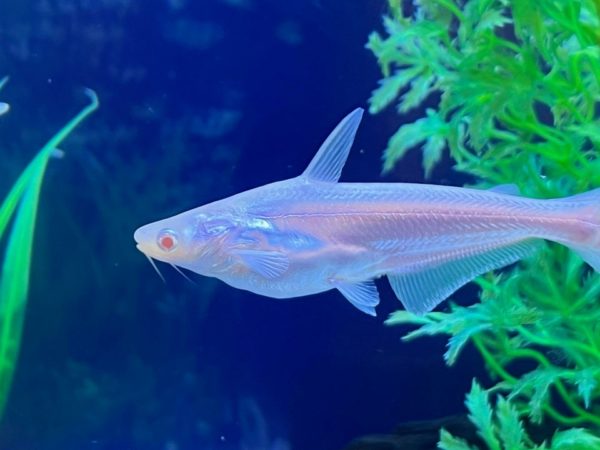
It is unlikely that they will bother any other fish in the tank, and thus, they are great tankmates and can adjust with any type of fish in the aquarium. Once scared, they practice numerous survival tactics like acting dead. If you see such circumstances, do not worry; wait for some time and see them getting back to their normal activities. However, keep track of it if it happens again and again.
Is Iridescent Shark Lone Or Societal?
Living alone in the water is not natural for these fish, and they can get stressed and even depressed if kept by themselves for too long. This should not be something you want for your aquarium, so it is recommended to have a school of somewhere around 4-5 iridescent shark fish in a tank to keep them comfortable. Other tank mates are also good options, but studies show that schooling is important for the iridescent shark.
Iridescent Shark Tank Mates
Even though iridescent sharks are a peaceful and non-aggressive species, finding a good tank mate is not easy. Many aggressive fish species tend to harass them because your iridescent shark can get depressed. Moreover, this species of catfish eat everything that they see, so keeping smaller fish can be a little risky.
Ideal Iridescent Shark Tank Mates
Adjustment plays a crucial role in keeping two or more fish together. While juvenile fish tend to school together, adults grow away from each other. Below are some compatible fish for residing with your iridescent shark in the tank.
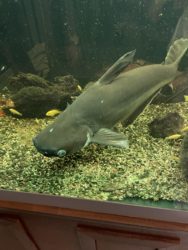
Keeping another iridescent shark is a good option for your iridescent to socialize. Make sure to keep 4-5 fish with your iridescent shark as this species of catfish gets lonely very easily.
- Large plecos
- Black shark
- Pearse
- Texas cichlid
- Oscar fish
- Bichir
- Fire eel
- Silver dollar fish
- Synodontis catfish
- Leptobotia elongata loach
- Kissing gourami
- Salvin’s cichlid
Bad Tank Mates For Iridescent Shark
Always avoid pairing your Iridescent shark with aggressive fish. They can bully your fish, and thus, your iridescent can get scared.
Moreover, don’t keep small fish with your catfish. Your iridescent will more likely eat them. Here is a list of fishes you must avoid your iridescent to stay with.
- Tetras
- Danios
- Barbs
- crustaceans
Breeding Iridescent Sharks
Getting the right tank mates is one thing. Still, you also need to consider if you would be interested in breeding your iridescent shark. If so, you would need a male and a female iridescent shark, but after that comes the bad news. The iridescent shark is considered close to impossible to breed in captivity, and this is due to the difficulties in recreating the right conditions for this to happen naturally. The iridescent shark is a migrating fish, something that means that during the breeding season (late summer), the fish will travel upstream with the rising water levels, where it will then go on to breed.
No size of aquarium is big enough for this to be a possibility, and it seems that unless the iridescent shark can migrate, it has no interest in breeding, even if there are both male and female fish in the tank. It is irrelevant what size your aquarium is, as not even the biggest size available is likely to inspire your iridescent shark to want to breed.
As this species cannot be bred in captivity, it is incredibly important for them to be preserved in their natural habitat and allowed to continue migrating and breeding there. So, if you had the hopes of breeding your iridescent shark somewhere down the line, then you are unfortunately up for some disappointment.
Iridescent Shark Breeding Level – Easy/Intermediate/Hard
It is very difficult to breed iridescent sharks in an aquarium. They do not tend to breed in captivity. And since they are migrating fish, they always need natural habitat to breed.
Iridescent Shark Sexual Dimorphism
To distinguish between a male and female iridescent shark, we need to see their size. Female iridescent are generally larger and rounder than males. However, the size largely depends upon the school they have grown up in and their food habits.
You cannot see many behavioral differences, but while putting iridescent in a tank, it is good to keep more females than males if you want them to breed.
Iridescent Shark Common Diseases And Their Treatment
If you have planned to get an iridescent shark, it is your responsibility to make them feel comfortable. Since they grow in natural inhabitant, they can feel lonely and depressed while growing in a tank. That is why feeding and taking care of them is very important.
Your catfish can catch a few diseases common in their species. So, always watch them notice symptoms and start treatment before they become fatal. Here are some common diseases in iridescent sharks.
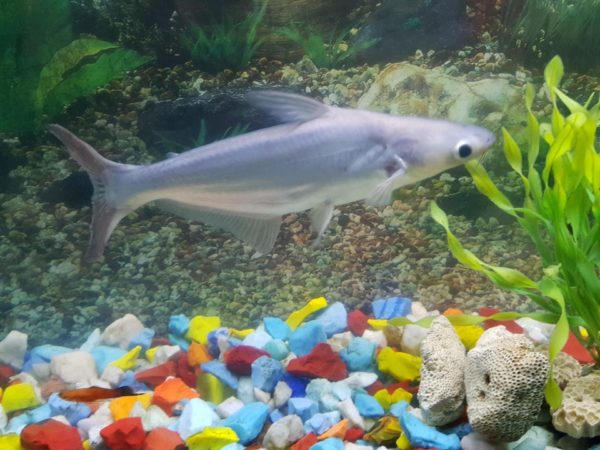
Skin Fungus
Bad and unhygienic water conditions can lead to fungal infection in the skin of your catfish. It is very difficult to see the symptoms in the initial phase since iridescent does not have a scale on its body, unlike other tank fishes. If you see irritable behavior and discoloration of skin in your catfish, it means there is a fungal infection. It is possible to treat this skin fungus by proper diet and hygienic surroundings.
Ich
Ich is a common disease in fish of all types. In this, you can notice spots and white dots on your fish’s skin and fin lining. These spots are itchy, so you may notice your fish trying to rub them over any solid object in the tank. But there is nothing to worry about as this disease has treatments. There are medicines available which can completely cure ich in your iridescent sharks.
Facts About Iridescent Shark
- Iridescent sharks have very poor eyesight and can barely see small obstacles around them.
- They are not sharks. They are from a catfish family and are called sharks because of their appearance.
- You can find this catfish easily as freshwater fish food in grocery stores where they call it ‘Swai.’
- Iridescent catfish migrate during the breeding season.
- They can easily get stressed in a stranger environment.
- Naturally, they are found in the Mekong river of South Asia.
Are Iridescent Sharks Right For You?
Iridescent sharks are among the largest freshwater fish available on the market to put in the tank. With its high maintenance and responsibility, many fear buying them. But in reality, many aquarists and even beginners enjoy keeping iridescent sharks in their houses.
It is crucial to take care of their food habits, and hygiene or their health may deteriorate. So, if you think you are ready to take up all these responsibilities, you can have fun with a couple of iridescent sharks in your house.
FAQs (Frequently Asked Questions)
Will Iridescent Sharks Eat Fish?
Yes. This fish is an omnivore and eats both animal-based and plant-based food, and they will happily eat small fish despite not being aggressive fish.
Do Iridescent Sharks Play Dead?
Sometimes, especially when scared, this fish might choose to play dead. If your fish is floating around in the water, double-check to make sure it isn’t just pretending before removing it from the water.
How do Big Do Iridescent Sharks get?
Expect an adult size of up to 4 feet.
Are Iridescent Sharks Aggressive?
These large fish are not usually considered aggressive, and they also tend to live peacefully when kept in a tank with other fish. However, it is always good to be vigilant, especially if you have just introduced a new fish to the tank, and to consider rehoming any fish displaying repeated aggressive behavior.
How Do You Take Care Of An Iridescent Shark?
As long as you have a generously sized tank that can provide your fish with adequate space, water with the temperature 72 to 79 degrees (F), water pH 6 and up, your iridescent shark only requires quality food and nutrition clean tank and appropriate tank mates.
Are Iridescent Sharks Nocturnal?
Catfish are nocturnal, but the iridescent shark is an exception! It tends to be the most active during the day, and it is generally found to be completely inactive at nighttime.
Conclusion
There is definitely some work that comes with having iridescent sharks in your tank, but the biggest challenge is to provide them with a big enough tank – the right size for them to swim around and thrive. Yes, it is considered a fish for the experienced aquarium owner, but most of this has to do with space and how far from everyone can provide properly for such a large animal. If you can provide an aquarium the size they need, you are likely to find great joy in having this fun catfish swimming around.
No related posts.
